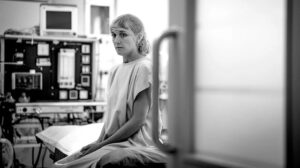 I sat there, frozen in time, full of fear, full of anxiety. Waiting for my time to “face the music,” but this wasn’t a dance party.
I sat there, frozen in time, full of fear, full of anxiety. Waiting for my time to “face the music,” but this wasn’t a dance party.
My fellow patients, complete strangers, were seated about me, and each of us kept a safe distance apart from each other – a carry-over from the pandemic, I guess. All of us waiting to get our news – a thumbs up or thumbs down…
For me, it is a yearly appointment with my specialist evaluating my bloodwork. I really didn’t know what to expect, and so I was pretty anxious sitting there, trying to remember to breathe. Will I hear good news or will it be something that sends me to the floor?
My eyes darted about the waiting room, quick glances at the other patients. Some were staring at their feet, some stared intently into an outdated magazine with curled up corners, and some looked at framed artwork on the wall, seemingly from a “starving artist” sale. Some merely stared into space.
I wondered what their individual stories were – a new cancer diagnosis, a cancer in remission, or waiting to hear results from recent tests.
There were no smiling faces, but rather pensive looks. No small talk. Just the sound of an occasional nervous cough, a clearing of one’s throat. The room was quiet, but the thoughts were loud.
The endless wait to hear your name called.
The endless wait to find out if you were given a reprieve or to find out if the battle was about to begin.
Every second of every minute of every hour of every day, someone or someone you know receives a diagnosis of cancer. A period of time ago, this diagnosis was considered a death sentence, but with new forms of treatment becoming available, life expectancy rates for some forms of cancer have been lengthened, bringing with it glimmers of hope for a future for the patient.
 As part of the overall experience of receiving a cancer diagnosis, the patient becomes a regular visitor to various types of waiting rooms – lab annex for blood draws, hospital waiting rooms for such tests as MRI, ultrasound, CT scan, X-ray, and lastly, the waiting room for the oncologist visit. With each type of visit, there usually is a heightened level of anxiety for the patient. The uncertainty of results, along with undergoing the procedure itself, brings a level of stress and fear to the patient, especially if the experience is an unfamiliar one.
As part of the overall experience of receiving a cancer diagnosis, the patient becomes a regular visitor to various types of waiting rooms – lab annex for blood draws, hospital waiting rooms for such tests as MRI, ultrasound, CT scan, X-ray, and lastly, the waiting room for the oncologist visit. With each type of visit, there usually is a heightened level of anxiety for the patient. The uncertainty of results, along with undergoing the procedure itself, brings a level of stress and fear to the patient, especially if the experience is an unfamiliar one.
As a patient, one is usually given in advance an explanation of what is to take place for a particular procedure, but for many of us, it becomes a frightening experience when that moment actually arrives, when you are facing the situation head on.
The longer the time a patient has to remain in a waiting room, generally the higher the level of anxiety that is created by doing so. Therefore, some forethought should be given to make this time of waiting less traumatic. Spacious rooms given an airy atmosphere, rooms with windows with views to an outside area may lessen tension. Restful pastoral artwork appropriately placed within the space may help, along with easy listening music being played may also reduce tension. Such items as current magazines, newspapers, and TV, if made available, may allow the patient to become distracted from simply having to worry about what is awaiting him. If the situation allows, maybe handing out a “beeper” to the patient so that he might have the freedom to wander a bit, rather than being confined to a seat in a room with nothing else to do but worry.
As I sat there in that waiting room and looked out about me – young, old, men, women – none of us chose to be there, none of us would have chosen to become a member of the “cancer club,” but here we were scattered about the room waiting. Waiting in fear.
Written by Michele Luckenbaugh for Kevin MD ~ March 17, 2024
